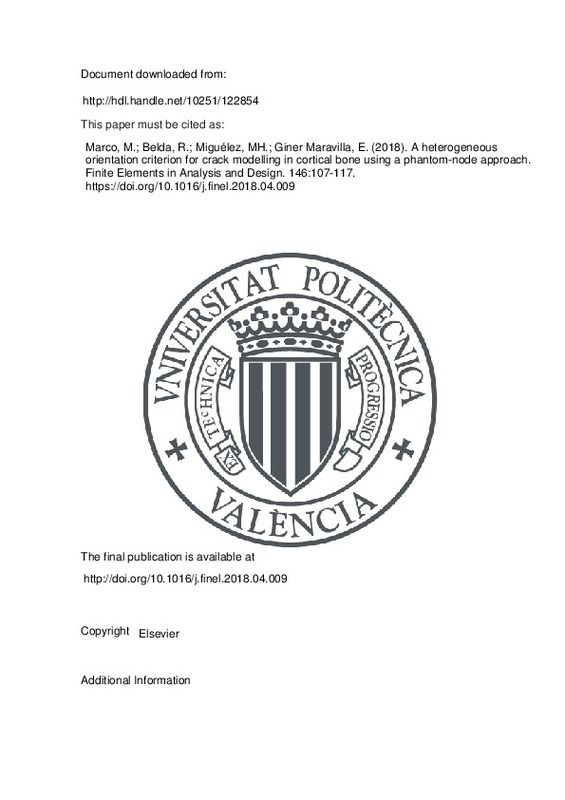JavaScript is disabled for your browser. Some features of this site may not work without it.
Buscar en RiuNet
Listar
Mi cuenta
Estadísticas
Ayuda RiuNet
Admin. UPV
A heterogeneous orientation criterion for crack modelling in cortical bone using a phantom-node approach
Mostrar el registro sencillo del ítem
Ficheros en el ítem
| dc.contributor.author | Marco, Miguel
|
es_ES |
| dc.contributor.author | Belda, R.
|
es_ES |
| dc.contributor.author | Miguélez, María Henar
|
es_ES |
| dc.contributor.author | Giner Maravilla, Eugenio
|
es_ES |
| dc.date.accessioned | 2019-06-28T20:01:36Z | |
| dc.date.available | 2019-06-28T20:01:36Z | |
| dc.date.issued | 2018 | es_ES |
| dc.identifier.issn | 0168-874X | es_ES |
| dc.identifier.uri | http://hdl.handle.net/10251/122854 | |
| dc.description.abstract | [EN] Cortical bone can be considered as a heterogeneous composite at microscopic scale, composed of osteons that act as reinforcement fibres embedded in interstitial matrix. Cement lines constitute the interface between osteons and matrix, and they often behave as the weakest links along which microcracks tend to propagate. However, current simulations of crack growth using XFEM combined with usual orientation criteria as implemented in commercial codes do not capture this behaviour: they predict crack paths that do not follow the cement lines surrounding osteons. The reason is that the orientation criterion used in the implementation of XFEM does not take into account the heterogeneity of the material, leading to simulations that differ from experimental results. In this work, a crack orientation criterion for heterogeneous materials based on interface damage prediction in composites is proposed and a phantom node approach has been implemented to model crack propagation. The method has been validated by means of linear elastic fracture mechanics (LEFM) problems obtaining accurate results. The procedure is applied to different problems including several osteons with simplified geometry and an experimental test reported in the literature leading to satisfactory predictions of crack paths. | es_ES |
| dc.description.sponsorship | The authors gratefully acknowledge the funding support received from the Spanish Ministry of Economy and Competitiveness and the FEDER operation program in the framework of the projects DPI2013-46641-R, DPI2017-89197-C2 and RTC-2015-3887-8 and also from the Generalitat Valenciana through the Programme PROMETEO 2016/007. | es_ES |
| dc.language | Inglés | es_ES |
| dc.publisher | Elsevier | es_ES |
| dc.relation.ispartof | Finite Elements in Analysis and Design | es_ES |
| dc.rights | Reconocimiento - No comercial - Sin obra derivada (by-nc-nd) | es_ES |
| dc.subject | Crack path | es_ES |
| dc.subject | Heterogeneous media | es_ES |
| dc.subject | Orientation criterion | es_ES |
| dc.subject | Phantom node method | es_ES |
| dc.subject | Bone fracture | es_ES |
| dc.subject.classification | INGENIERIA MECANICA | es_ES |
| dc.title | A heterogeneous orientation criterion for crack modelling in cortical bone using a phantom-node approach | es_ES |
| dc.type | Artículo | es_ES |
| dc.identifier.doi | 10.1016/j.finel.2018.04.009 | es_ES |
| dc.relation.projectID | info:eu-repo/grantAgreement/AEI/Plan Estatal de Investigación Científica y Técnica y de Innovación 2013-2016/DPI2017-89197-C2-2-R/ES/TALADRADO DE COMPONENTES HIBRIDOS CFRPS%2FTI Y TOLERANCIA AL DAÑO DEBIDO A MECANIZADO DURANTE EL COMPORTAMIENTO EN SERVICIO DE UNIONES ESTRUCTURALES AERONAUTICAS/ | es_ES |
| dc.relation.projectID | info:eu-repo/grantAgreement/GVA//PROMETEO%2F2016%2F007/ES/Modelado numérico avanzado en ingeniería mecánica/ | es_ES |
| dc.relation.projectID | info:eu-repo/grantAgreement/MINECO//DPI2013-46641-R/ES/DESARROLLO DE MODELOS MICROESTRUCTURALES DE TEJIDO OSEO Y APLICACION A PROCEDIMIENTOS DE EVALUACION DEL RIESGO DE FRACTURA/ | es_ES |
| dc.relation.projectID | info:eu-repo/grantAgreement/MINECO//RTC-2015-3887-8Q4618002BC.VALENCIANA/ES/DISEÑO AVANZADO Y FABRICACIÓN DE PROTECCIONES PERSONALES INTEGRALES DE USO MILITAR Y PARA FUERZAS Y CUERPOS DE SEGURIDAD DEL ESTADO (PROTEC_DAF)/ | es_ES |
| dc.rights.accessRights | Abierto | es_ES |
| dc.contributor.affiliation | Universitat Politècnica de València. Departamento de Ingeniería Mecánica y de Materiales - Departament d'Enginyeria Mecànica i de Materials | es_ES |
| dc.description.bibliographicCitation | Marco, M.; Belda, R.; Miguélez, MH.; Giner Maravilla, E. (2018). A heterogeneous orientation criterion for crack modelling in cortical bone using a phantom-node approach. Finite Elements in Analysis and Design. 146:107-117. https://doi.org/10.1016/j.finel.2018.04.009 | es_ES |
| dc.description.accrualMethod | S | es_ES |
| dc.relation.publisherversion | http://doi.org/10.1016/j.finel.2018.04.009 | es_ES |
| dc.description.upvformatpinicio | 107 | es_ES |
| dc.description.upvformatpfin | 117 | es_ES |
| dc.type.version | info:eu-repo/semantics/publishedVersion | es_ES |
| dc.description.volume | 146 | es_ES |
| dc.relation.pasarela | S\363946 | es_ES |
| dc.contributor.funder | Generalitat Valenciana | es_ES |
| dc.contributor.funder | Agencia Estatal de Investigación | es_ES |
| dc.contributor.funder | Ministerio de Economía, Industria y Competitividad | es_ES |







![[Cerrado]](/themes/UPV/images/candado.png)

